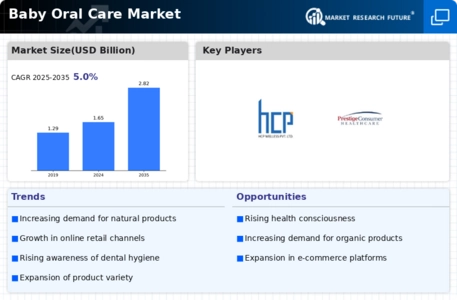Expansion of Retail Channels
The Baby Oral Care Market is experiencing an expansion of retail channels, making products more accessible to consumers. The proliferation of e-commerce platforms and the presence of baby care sections in supermarkets and pharmacies have facilitated easier access to a variety of oral care products. This increased availability is likely to drive sales, as parents can conveniently purchase items that meet their children's needs. Market data indicates that online sales of baby oral care products have surged, reflecting a shift in shopping habits. As retail channels continue to diversify, the Baby Oral Care Market is expected to grow, catering to a wider audience and enhancing consumer convenience.
Increasing Parental Awareness
The Baby Oral Care Market is experiencing a notable shift as parents become increasingly aware of the importance of oral hygiene for infants and toddlers. This heightened awareness is driven by educational campaigns and the dissemination of information regarding the long-term effects of poor oral health. As a result, parents are more inclined to invest in specialized oral care products designed for babies. Market data indicates that the demand for baby toothbrushes and fluoride-free toothpaste has surged, reflecting a growing commitment to early dental care. This trend suggests that as parents prioritize their children's health, the Baby Oral Care Market is likely to expand, with innovative products catering to this conscientious demographic.
Rise of Organic and Natural Products
The Baby Oral Care Market is witnessing a significant rise in the demand for organic and natural products. Parents are increasingly concerned about the ingredients in oral care items, opting for products that are free from harmful chemicals and additives. This trend aligns with a broader movement towards natural and organic consumer goods, as parents seek to provide the safest options for their children. Market data reveals that sales of organic baby toothpaste have seen a substantial increase, indicating a shift in consumer preferences. This inclination towards natural products not only enhances the appeal of the Baby Oral Care Market but also encourages manufacturers to innovate and expand their product lines to meet these evolving demands.
Growing Influence of Pediatric Dentists
The Baby Oral Care Market is significantly influenced by the recommendations of pediatric dentists. As healthcare professionals emphasize the importance of early dental care, parents are more likely to follow their advice regarding suitable oral care products for their children. This influence is evident in the rising sales of dentist-recommended brands and products specifically designed for infants and toddlers. Pediatric dentists are increasingly advocating for regular dental check-ups and the use of specialized baby oral care items, which may lead to a more informed consumer base. Consequently, the Baby Oral Care Market is poised for growth as parents align their purchasing decisions with professional guidance.
Technological Advancements in Product Design
The Baby Oral Care Market is benefiting from technological advancements that enhance product design and functionality. Innovations such as ergonomic toothbrush designs and interactive dental care apps are becoming increasingly popular among parents. These advancements not only improve the user experience but also encourage children to engage in oral hygiene practices from an early age. Market data suggests that products incorporating technology, such as smart toothbrushes that track brushing habits, are gaining traction. This integration of technology into the Baby Oral Care Market may lead to increased sales and consumer loyalty, as parents seek products that make oral care more enjoyable and effective for their children.

















Leave a Comment